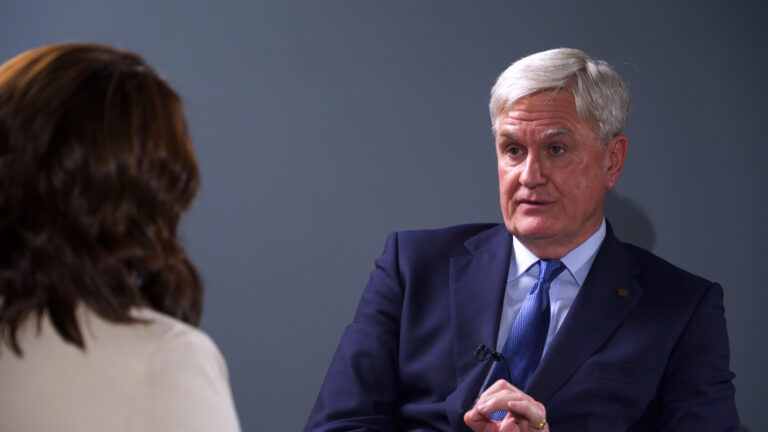ASTANA — Kazakhstan’s economic diversification efforts and focus on digital transformation are opening new avenues for growth, particularly in financial services and trade, according to David Livingstone, Citi’s Chief Client Officer. In an interview for The Astana Times YouTube channel, Livingstone reflected on Citi’s 31-year presence in Kazakhstan and how the country’s evolving strategy aligns with the bank’s global expertise.
Photo Credit: The Astana Times
“Kazakhstan’s policy approach is rightly expansive. It’s not only focused on economic growth, but also on diversifying beyond traditional strengths like energy and minerals,” Livingstone said, noting that digitization is at the heart of that strategy.
He said that financial services are at the forefront of this shift. Since 2022, Citi has closely collaborated with the Kazakh government to advance digital solutions, formalizing this partnership through a memorandum of understanding that supports key areas of digitization.
“We’ve partnered with the government to support digitization, and that’s becoming even more critical as we move into the realm of digital assets. This transition raises important regulatory questions, especially as these assets increasingly serve as instruments of innovation in financial services,” he said.
Despite Kazakhstan’s progress in attracting investments, raising awareness among international investors remains to be key, according to Livingstone.

Photo Credit: The Astana Times
“Kazakhstan has made strong strides in attracting investments, and momentum is building,” said Livingstone. “That said, like many emerging markets, continued engagement is key and we’re working to keep institutional and strategic investors informed about the exciting opportunities that exist here.”
To address this, Citi hosted a major Kazakh government delegation at its New York headquarters last year, where dozens of investors received comprehensive updates on Kazakhstan’s economic development.
Digital Tenge and the future of currency
Livingstone also noted that digitization is happening everywhere, and Kazakhstan is part of that global trend. He stressed that digitization is borderless, allowing the country to leverage innovations Citi implements globally — in payments, custody, and foreign exchange.
“Wherever we see opportunities to digitize and innovate globally, we bring them to Kazakhstan. For example, here we execute tens of thousands of FX transactions for clients annually, and the speed and accuracy of these depend on continuous digital advancement. Kazakhstan is well-positioned to benefit from this momentum, and we are committed to supporting that journey,” he said.
Livingstone also commended the National Bank of Kazakhstan for its leadership in digital currency, particularly the implementation of the digital tenge.
“Central bank digital currencies are on the agenda everywhere, and Kazakhstan has been a relative leader,” he said. “The key question is: what problem does a digital currency solve? Most people here, including yourself, probably haven’t handled physical tenge in a long time. From banking to utilities, everything is already application-based and highly digital. In some countries, a digital currency fills a clear need. In others, like Kazakhstan, the use case might be less obvious, but still relevant,” he added.
He also highlighted the future of tokenization — the process of breaking down assets into tradable components — as a potential game-changer for Kazakhstan’s financial infrastructure.
“Reforms in digital assets, particularly tokenization, have immense potential to reshape the financial system. It can simplify everything from trading to custody and asset management. That’s where we see the next wave of innovation,” Livingstone said.
Trade, turbulence, and Kazakhstan’s strategic position
The discussion then shifted to Kazakhstan’s geographic and energy advantages. Livingstone sees the country’s vast energy resources not merely as a strength, but also as a gateway to building long-term trade advantages.
“Kazakhstan’s physical location, energy resources, and production capabilities position it uniquely along key trade corridors – from China to Europe via the Middle Corridor, and to India via the North-South Corridor. The government isn’t just aiming for Kazakhstan to be a transit point; it is focused on creating value within Kazakhstan,” he said.
As trade volumes grow, the accompanying financial needs, ranging from financing to market access, are also increasing.
“The regional hub in financial services comes on the back of being the regional physical hub. Kazakhstan has the advantages like geographic proximity and natural resources. When these are combined with the sophisticated financial regulation, which the country already has and continues to develop, this creates a synergy enabling its ambition to become a regional financial hub,” he added.
Global trade shift: services rise, protectionism spreads
Against this backdrop, global trade is going through a period of turbulence. According to the World Trade Organization’s (WTO) Global Trade Outlook, in 2024, global services trade grew by 15%, surpassing the growth of goods trade for the first time in history. This reflects a shift towards digital, knowledge-based industries and cross-border services such as IT, finance, and logistics.
Livingstone noted that it is not just what is being traded, but how trade is settled is undergoing significant disruption, driven in part by growing protectionist measures and the resurgence of the United States’ (U.S.) tariffs.
“It might sound obvious, but the way trade is settled is fundamental,” Livingstone said.
“And it’s not just being disrupted by potential tariffs. Tariffs have always existed, and the U.S. is not the only country taking steps to protect its own economy”, he said.
Livingstone pointed out that COVID-19 had already triggered major changes in global trade flows, and that recent geopolitical developments represent yet another catalyst for disruption.
“The question now is how the changes in global trade flows will settle, not only for goods, but in services as well. We often focus on physical trade of goods, but what about financial services, technology, and other elements of the services economy? How do they continue to grow, innovate, and thrive and in which geographies? Trade inherently involves friction – it crosses borders. So, it is crucial to understand where that friction ultimately settles”, he concluded, adding that he is recommending that I keep my journalistic eye on this topic.
Meanwhile, protectionism is on the rise. Since 2020, over 3,000 new trade restrictions have been introduced globally, with many targeting strategic sectors such as energy, technology, and critical raw materials. This reflects a shift toward economic nationalism, with governments using trade policy as a geopolitical tool to protect national interests and supply chains.
Livingstone offered a broader perspective on this shift, pointing to the diminishing effectiveness of multilateral frameworks such as the WTO.
“I’d characterize it slightly differently. The global trading system has faced challenges for some time. Institutions like the WTO, while foundational to multilateralism, haven’t been functioning as effectively as intended in recent years. What we are seeing from the US administration, and from many governments worldwide, is a reassessment of a fundamental question: under what terms should foreign companies access domestic markets? That includes financial terms, tariff structures, and increasingly, non-financial considerations.
Livingstone emphasized that when the US, the world’s largest economy, begins to reevaluate its approach to trade, it naturally has global implications.
“Many global companies and countries are deeply connected to the U.S. economy. Therefore, when the U.S. revisits these questions, it sends ripples across the global system”, he explained. “It’s part of the broader context that shapes where we are today, and understanding the U.S. perspective is essential for navigating the future of global trade.”
For the complete conversation, stay tuned for the release of the full video interview on The Astana Times’ YouTube channel.
